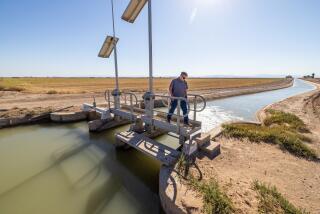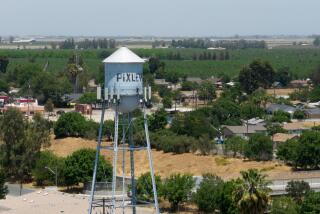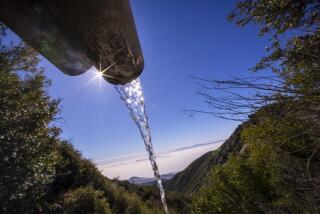A Settlement That’s All Wet
- Share via
For two decades the 650,000-acre Westlands Water District in the San Joaquin Valley has battled to maintain its envied and lucrative position as one of the most heavily subsidized agencies ever organized under federal reclamation law. Today it appears that Westlands has won just about everything that it fought for. In the end the U.S. Interior Department, representing the people of the United States, gave in with hardly a whimper.
Thus for 22 more years Westlands will receive an assured annual supply of 900,000 acre-feet of irrigation water from the federal Central Valley Project (more than the City of Los Angeles uses in a year) at the bargain rate of $8 an acre-foot--about 4% of urban water costs in Southern California. The Fresno-based district will receive 250,000 to 350,000 more acre-feet at a higher price, $16.40 an acre-foot, but still far below cost.
Westlands can use its water on 156,000 acres of land that Interior contended in the past was never made a legal part of the water district and therefore was not entitled to receive water from the federal project.
The water will continue to irrigate massive acreages of surplus crops for which there are no markets and that are propped up by the runaway federal price-support program. And the used irrigation water that runs off the fields will add to the long-range San Joaquin Valley pollution problem that no one knows how to solve.
By agreeing to an out-of-court settlement of Westlands’ lawsuit against the Interior Department, Interior has let slip by an opportunity to advance the long struggle to reform the 1902 Reclamation Act and to enforce the spirit of modest reclamation reforms achieved by Congress in 1982. At all costs, Westlands wanted to avoid having to negotiate a new contract for all its water and therefore face more realistic prices demanded by the 1982 reform. This fact alone makes Westlands the big winner.
The Interior Department contends that the government does better, economically, by nearly $50 million over the life of the contract than it would have done under the most adverse possible ruling of the court. If that is so, why would Westlands settle rather than pursue its case?
The suit was initiated by Westlands in 1981, when then-Secretary of Interior James G. Watt threatened to cut off Westlands’ water unless the district agreed to pay the full cost of its federal water and to finance the entire burden of its waste-water drainage system. The key to Watt’s argument was a 1978 opinion by the Interior Department’s top lawyer, Leo Krulitz. It challenged the legality of many features of the Westlands project, including the use of water on land never formally made a part of the district. How did Interior get around this legal bottleneck in reaching Thursday’s settlement? Easy. The current solicitor, Ralph Tarr of Fresno, merely ruled that key parts of the Krulitz opinion were wrong.
Congress has 30 days to review the settlement, but cannot veto it. But there is ample time for protests to be lodged with the federal court in Fresno, which can. Rejection of the settlement clearly is in the public interest.
More to Read
Sign up for Essential California
The most important California stories and recommendations in your inbox every morning.
You may occasionally receive promotional content from the Los Angeles Times.










